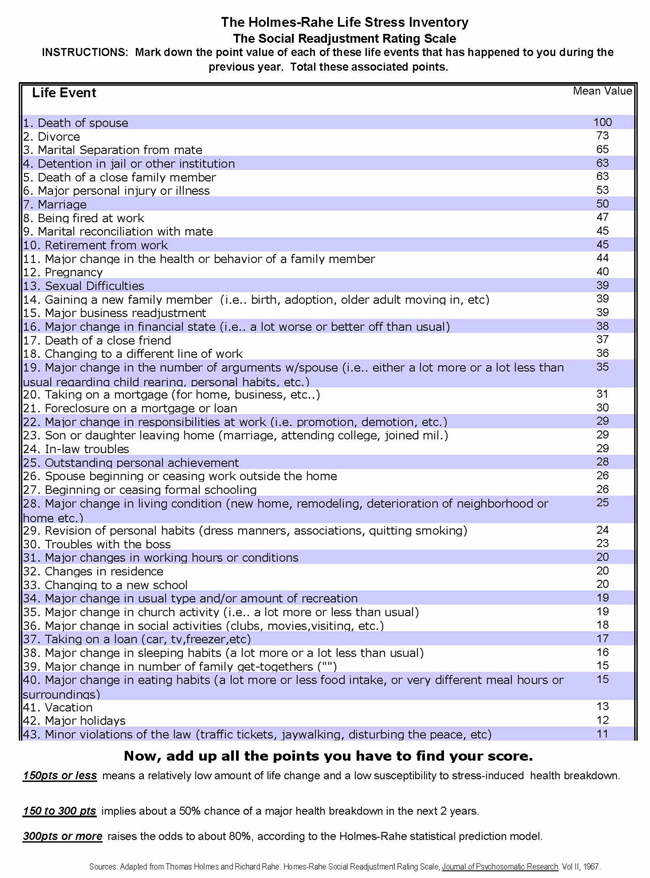Stressful times can take a toll on a person’s physical, psychological, and emotional well-being, and for those experiencing divorce transitions, the stress is taken to another level. According to the Social Readjustment Rating Scale (SRRS), also known as the Holmes and Rahe Stress Scale, developed by Thomas Holmes and Richard Rahe in 1967, “Divorce” is only second to “Death of a Spouse,” in terms of stressful life events. Each life event is given a score, and the higher the sum of the score of the events that have happened to a person in the past year, the greater the likelihood of suffering from stress and stress-related health effects. When going through divorce, additional stressors such as “Marital Separation from Mate,” “Major Change in Financial State,” “Major Change in Arguments with Spouse,” “Major Change in Living Conditions,” “Changes in Residence,” “Major Change in Sleeping Habits,” “Major Change in Family Get-Togethers” come into play, so it’s easy to see how the potential effects and transitions involved in divorce add up to create a level of stress that can become more than a personal can handle on their own (McLeod, 2023).

The Holmes and Rahe Life Stress Inventory and Rating Scale
The Holmes and Rahe Life Stress Inventory and Rating Scale illustrates how the point values given to these and other stressors can easily add up to the 300 life units to result in a person having an 80% chance of developing a stress-related illness (McLeod, 2023).
And when the stress of divorce is combined with the stresses involved in raising a child on the autism spectrum, the impact on a parent can be immense. Besides the usual decisions that need to be made in divorce, such as dividing the marital estate, determining financial support to be made, and creating a parenting plan, parents also need to plan for the current and future needs of children on the autism spectrum, especially when that child will need ongoing support. This is in addition to the emotional upheaval that is a part of divorce, especially if one parent was not expecting a separation to occur. So what is a parent to do when facing such family transitions and challenges? How can they navigate the divorce process while taking care of themselves and their children?
Even if a busy parent has not had or made time for self-care in the past, this is the time to try to find a way to decompress and regroup so that the extra stresses and demands of the divorce process don’t engulf all the family members. This could be as simple as taking a few minutes of downtime, focusing on something pleasant to get the mind thinking about something different, or getting some exercise or a change of scenery. Then, hopefully, after this break, the harried parent can reset and refocus on taking care of their child in a more positive fashion or attend to tasks needing to get done in the divorce with a clearer head.
But self-initiated self-care alone is not usually enough to overcome the challenges and stresses faced in divorce by parents of children on the spectrum. There are many professionals who can help by providing guidance and support to parents navigating divorce challenges and trying to care for their autistic child.
One such person is a Certified Special Needs Divorce Coach, who can share insights and resources to help parents overwhelmed by various aspects of the divorce process and support the parents with strategies so they can help not only themselves but also more effectively advocate for the child’s unique needs.
Some Certified Divorce Coaches are also Pre-Mediation Divorce Coaches who help a parent prepare for mediation with skills, techniques, and information to reduce the stress and uncertainty in the mediation process. By showing up more confidently with an understanding of what it takes to be successful in mediation, the issues in divorce are more likely to be resolved in an amicable manner.
Another valuable member of the support team would be a mental health professional to help a parent and/or child process the grief and emotions involved in divorce and transitions. In some cases, a mental health or medical professional might also be important to the divorce case, sharing diagnoses or possible recommendations from an expert perspective.
Financial professionals with a knowledge of special needs considerations can provide helpful information to address the planning needs involved in providing for a child with a disability. By getting a better picture of the costs involved in raising and supporting the child’s complex needs, as well as potential sources of income, parents can go into divorce meetings with more information, thus lowering the stress related to uncertainty about future needs.
And of course, legal professionals with experience in special needs cases and planning issues are important members to have on the team. This is not just a family law attorney for the divorce advocacy aspects, understanding rights and duties of each party, and how a specific jurisdiction handles issues related to a young or adult child with a disability, but also an estate planning attorney to set up trusts and documents for the care and protection related to the child with a disability.
Working with Mediators and Parenting Coordinators can also be helpful to help both parents find common ground and approaches to reduce stress and have a child-centered divorce. Though some people think of mediation as a stressful one-time opportunity to try to come to a resolution, there are mediators who can meet with parents over multiple sessions to work on issues important to the family.
There may be groups and additional resources in the community, whether in-person or online, which can be of great support in helping parents through special needs divorce challenges. Many communities have helpful Facebook groups with members sharing tips and resources, and a new website, Divorce With Special Needs Children, was developed to share names of professionals with expertise supporting families with a child with complex needs, to be of support to parents before, during, and after divorce.
The more a parent understands what is involved in divorce and who can help support them in the process, the less stress a parent will continue to experience, to hopefully reduce their anxiety about the process, their needs, and the needs of their child on the autism spectrum. By reducing stress in divorce and increasing resilience, the hope is that life during and after divorce will be much calmer for all those involved, especially the child with autism, and that each family member can find new opportunities to thrive post-divorce.
Mary Ann Hughes, MBA, is a Certified Special Needs Divorce Coach and is Founder of Special Family Transitions LLC. For more information and resources on special needs divorce, please visit SpecialFamilyTransitions.com and follow on Facebook, Instagram, and YouTube. You can also reach Mary Ann at maryann@specialfamilytransitions.com.
Reference
McLeod, S., PhD. (2023). Social Readjustment Rating Scale (SRRS). Simply Psychology. https://www.simplypsychology.org/srrs.html






